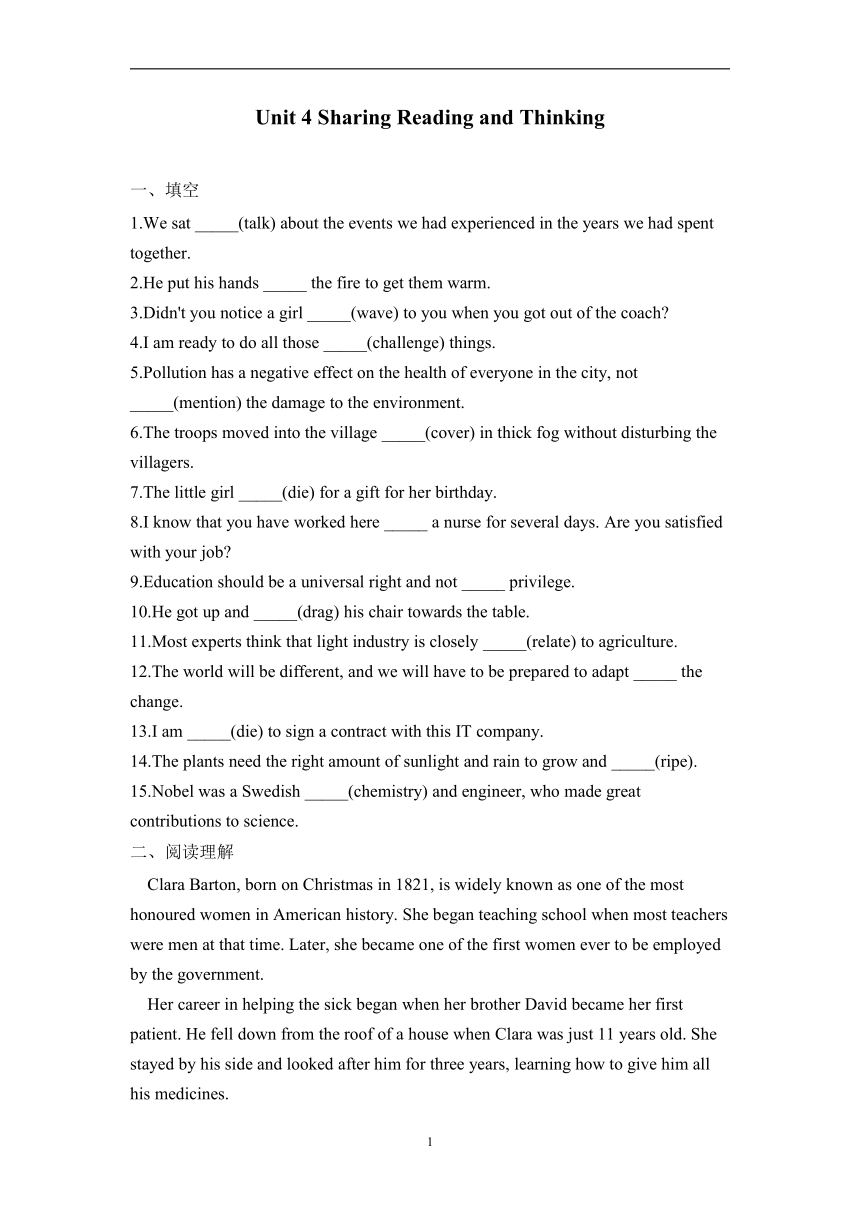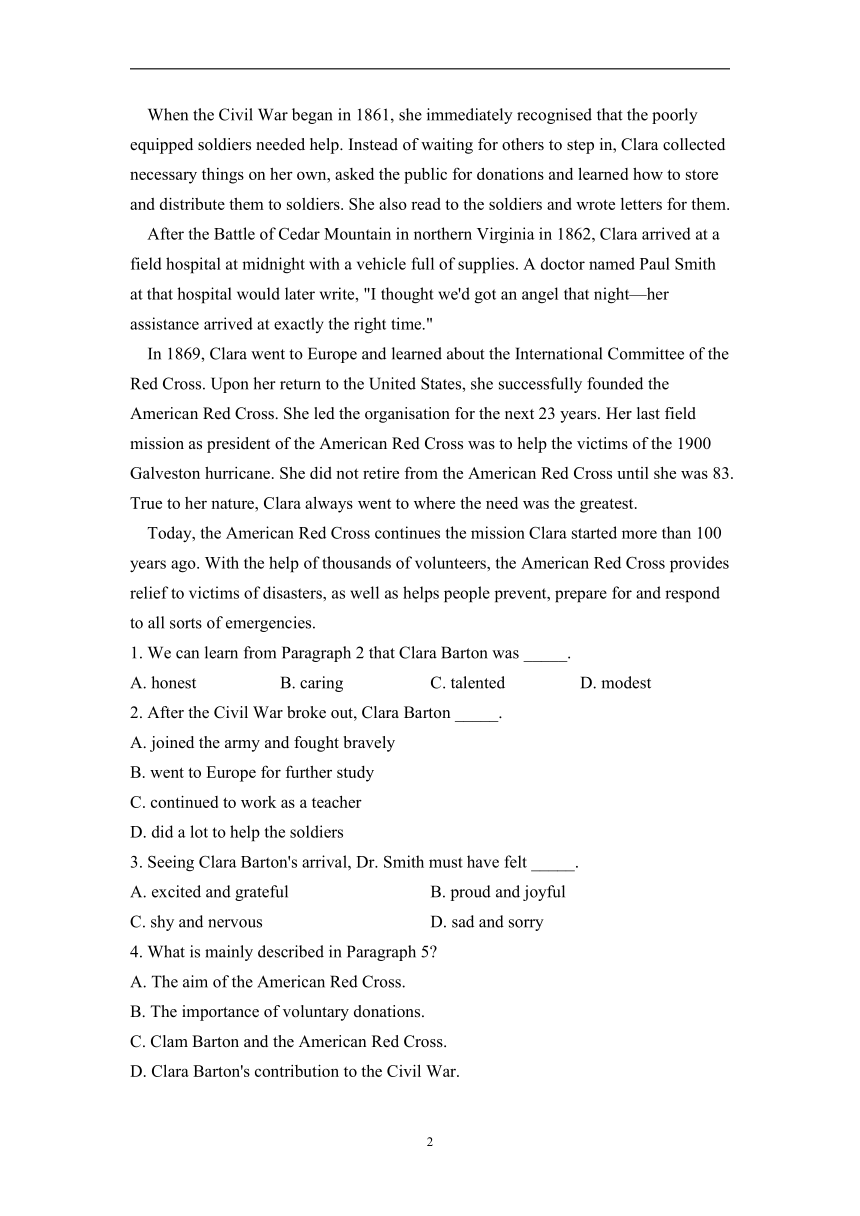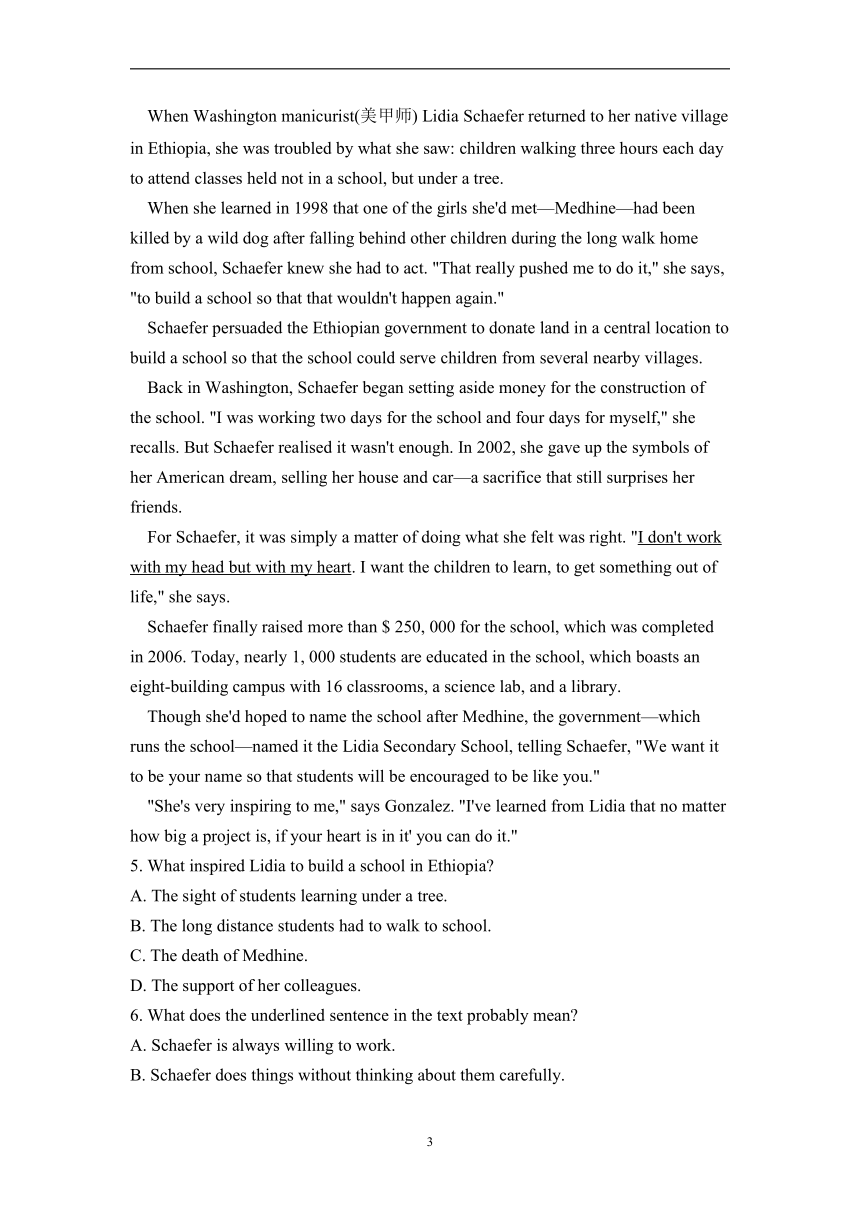人教版(2019)选择性必修第四册课Unit 4 Sharing Reading and Thinking课时练习(有答案)
文档属性
| 名称 | 人教版(2019)选择性必修第四册课Unit 4 Sharing Reading and Thinking课时练习(有答案) |  | |
| 格式 | docx | ||
| 文件大小 | 24.1KB | ||
| 资源类型 | 教案 | ||
| 版本资源 | 人教版(2019) | ||
| 科目 | 英语 | ||
| 更新时间 | 2023-03-07 12:22:55 | ||
图片预览



文档简介
Unit 4 Sharing Reading and Thinking
一、填空
1.We sat _____(talk) about the events we had experienced in the years we had spent together.
2.He put his hands _____ the fire to get them warm.
3.Didn't you notice a girl _____(wave) to you when you got out of the coach
4.I am ready to do all those _____(challenge) things.
5.Pollution has a negative effect on the health of everyone in the city, not _____(mention) the damage to the environment.
6.The troops moved into the village _____(cover) in thick fog without disturbing the villagers.
7.The little girl _____(die) for a gift for her birthday.
8.I know that you have worked here _____ a nurse for several days. Are you satisfied with your job
9.Education should be a universal right and not _____ privilege.
10.He got up and _____(drag) his chair towards the table.
11.Most experts think that light industry is closely _____(relate) to agriculture.
12.The world will be different, and we will have to be prepared to adapt _____ the change.
13.I am _____(die) to sign a contract with this IT company.
14.The plants need the right amount of sunlight and rain to grow and _____(ripe).
15.Nobel was a Swedish _____(chemistry) and engineer, who made great contributions to science.
二、阅读理解
Clara Barton, born on Christmas in 1821, is widely known as one of the most honoured women in American history. She began teaching school when most teachers were men at that time. Later, she became one of the first women ever to be employed by the government.
Her career in helping the sick began when her brother David became her first patient. He fell down from the roof of a house when Clara was just 11 years old. She stayed by his side and looked after him for three years, learning how to give him all his medicines.
When the Civil War began in 1861, she immediately recognised that the poorly equipped soldiers needed help. Instead of waiting for others to step in, Clara collected necessary things on her own, asked the public for donations and learned how to store and distribute them to soldiers. She also read to the soldiers and wrote letters for them.
After the Battle of Cedar Mountain in northern Virginia in 1862, Clara arrived at a field hospital at midnight with a vehicle full of supplies. A doctor named Paul Smith at that hospital would later write, "I thought we'd got an angel that night—her assistance arrived at exactly the right time."
In 1869, Clara went to Europe and learned about the International Committee of the Red Cross. Upon her return to the United States, she successfully founded the American Red Cross. She led the organisation for the next 23 years. Her last field mission as president of the American Red Cross was to help the victims of the 1900 Galveston hurricane. She did not retire from the American Red Cross until she was 83. True to her nature, Clara always went to where the need was the greatest.
Today, the American Red Cross continues the mission Clara started more than 100 years ago. With the help of thousands of volunteers, the American Red Cross provides relief to victims of disasters, as well as helps people prevent, prepare for and respond to all sorts of emergencies.
1. We can learn from Paragraph 2 that Clara Barton was _____.
A. honest B. caring C. talented D. modest
2. After the Civil War broke out, Clara Barton _____.
A. joined the army and fought bravely
B. went to Europe for further study
C. continued to work as a teacher
D. did a lot to help the soldiers
3. Seeing Clara Barton's arrival, Dr. Smith must have felt _____.
A. excited and grateful B. proud and joyful
C. shy and nervous D. sad and sorry
4. What is mainly described in Paragraph 5
A. The aim of the American Red Cross.
B. The importance of voluntary donations.
C. Clam Barton and the American Red Cross.
D. Clara Barton's contribution to the Civil War.
When Washington manicurist(美甲师) Lidia Schaefer returned to her native village in Ethiopia, she was troubled by what she saw: children walking three hours each day to attend classes held not in a school, but under a tree.
When she learned in 1998 that one of the girls she'd met—Medhine—had been killed by a wild dog after falling behind other children during the long walk home from school, Schaefer knew she had to act. "That really pushed me to do it," she says, "to build a school so that that wouldn't happen again."
Schaefer persuaded the Ethiopian government to donate land in a central location to build a school so that the school could serve children from several nearby villages.
Back in Washington, Schaefer began setting aside money for the construction of the school. "I was working two days for the school and four days for myself," she recalls. But Schaefer realised it wasn't enough. In 2002, she gave up the symbols of her American dream, selling her house and car—a sacrifice that still surprises her friends.
For Schaefer, it was simply a matter of doing what she felt was right. "I don't work with my head but with my heart. I want the children to learn, to get something out of life," she says.
Schaefer finally raised more than $ 250, 000 for the school, which was completed in 2006. Today, nearly 1, 000 students are educated in the school, which boasts an eight-building campus with 16 classrooms, a science lab, and a library.
Though she'd hoped to name the school after Medhine, the government—which runs the school—named it the Lidia Secondary School, telling Schaefer, "We want it to be your name so that students will be encouraged to be like you."
"She's very inspiring to me," says Gonzalez. "I've learned from Lidia that no matter how big a project is, if your heart is in it' you can do it."
5. What inspired Lidia to build a school in Ethiopia
A. The sight of students learning under a tree.
B. The long distance students had to walk to school.
C. The death of Medhine.
D. The support of her colleagues.
6. What does the underlined sentence in the text probably mean
A. Schaefer is always willing to work.
B. Schaefer does things without thinking about them carefully.
C. Schaefer doesn't like to use her head.
D. Schaefer bases what she does on her feelings.
7. The school was named after Schaefer because the government _____.
A. wanted the students to learn from her
B. wanted it to be in memory of her
C. wanted to express thanks to her
D. wanted to remember her forever
8. What can we conclude from Schaefer's experience
A. Houses and cars are the symbols of success.
B. You can do anything if you put your mind to it.
C. Money is the way to make a difference.
D. Your heart matters, not your head.
答案以及解析
一、填空
1.答案:talking
2.答案:over
3.答案:waving
4.答案:challenging
5.答案:to mention
6.答案:covered
7.答案:was dying
8.答案:as
9.答案:a
解析:考查冠词。句意:教育应当是全民的权利而非某部分人特别享有的。privilege意为“优惠待遇”,是可数名词,且此处是泛指。故填不定冠词a。
10.答案:dragged
解析:考查时态。句意:他站起来把他的椅子拖向桌子。根据got可知此处应用一般过去时,故填dragged。
11.答案:related
解析:考查固定搭配。句意:大部分的专家认为,轻工业和农业密切相关。be related to…与……有关。故填related。
12.答案:to
解析:考查固定搭配。句意:世界会变得不同,我们必须做好准备以适应这一变化。adapt to意为“适应……”,是固定搭配,故填介词to。
13.答案:dying
解析:考查固定搭配。句意:我渴望与这家IT公司签署一份合同。be dying to do…渴望做……。故填dying。
14.答案:ripen
解析:考查动词。句意:植物需要适量的阳光和雨水来生长成熟。根据grow and可知此处应用动词,ripe是形容词,其动词形式为ripen。
15.答案:chemist
解析:考查名词。句意:诺贝尔是一位瑞典化学家和工程师,对科学做出了巨大的贡献。此处指化学家。故填chemist。
二、阅读理解
答案:1-4 BDAC
解析:1.细节理解题。由第二段中的“She stayed by his side and looked after him for three years”可知, Clara Barton懂得关心体贴他人,故选B项。
2.细节理解题。由第三段中的"Clara collected necessary things on her own…and wrote letters for them."可知,美国内战爆发后,为了帮助士兵, Clara Barton做了很多援助工作,故选D项。
3.推理判断题。由第四段中的"Clara arrived…with a vehicle full of supplies"和Paul Smith后来所写的'I thought we'd got an angel that night—her assistance arrived at exactly the right time."可知, Clara Barton的到来让Paul Smith既兴奋又感激,故选A项。
4.段落大意题。本段主要介绍了Clara Barton创立的美国红十字会以及她为其发展所做出的不懈努力,故选C项。
答案:5-8 CDAB
解析:5.细节理解题。根据第二段的"That really pushed me to do it,' she says, 'to build a school so that wouldn't happen again."可知她是在知道自己认识的一个女孩死去后才真正开始行动起来的。故选C项。
6.细节理解题。结合前面的"…it was simply a matter of doing what she felt was right."可知,她做事情是按照自己认为对的去做的,故选D项。
7.细节理解题。根据倒数第二段的"We want it to be your name so that students will be encouraged to be like you."可知政府以她的名字来命名这个学校的目的是希望更多的学生像她一样。故选A项。
8.推理判断题。由最后一段的"I've learned from Lidia that no matter how big a project is, if your heart is in it, you can do it."可知选B项。
2
一、填空
1.We sat _____(talk) about the events we had experienced in the years we had spent together.
2.He put his hands _____ the fire to get them warm.
3.Didn't you notice a girl _____(wave) to you when you got out of the coach
4.I am ready to do all those _____(challenge) things.
5.Pollution has a negative effect on the health of everyone in the city, not _____(mention) the damage to the environment.
6.The troops moved into the village _____(cover) in thick fog without disturbing the villagers.
7.The little girl _____(die) for a gift for her birthday.
8.I know that you have worked here _____ a nurse for several days. Are you satisfied with your job
9.Education should be a universal right and not _____ privilege.
10.He got up and _____(drag) his chair towards the table.
11.Most experts think that light industry is closely _____(relate) to agriculture.
12.The world will be different, and we will have to be prepared to adapt _____ the change.
13.I am _____(die) to sign a contract with this IT company.
14.The plants need the right amount of sunlight and rain to grow and _____(ripe).
15.Nobel was a Swedish _____(chemistry) and engineer, who made great contributions to science.
二、阅读理解
Clara Barton, born on Christmas in 1821, is widely known as one of the most honoured women in American history. She began teaching school when most teachers were men at that time. Later, she became one of the first women ever to be employed by the government.
Her career in helping the sick began when her brother David became her first patient. He fell down from the roof of a house when Clara was just 11 years old. She stayed by his side and looked after him for three years, learning how to give him all his medicines.
When the Civil War began in 1861, she immediately recognised that the poorly equipped soldiers needed help. Instead of waiting for others to step in, Clara collected necessary things on her own, asked the public for donations and learned how to store and distribute them to soldiers. She also read to the soldiers and wrote letters for them.
After the Battle of Cedar Mountain in northern Virginia in 1862, Clara arrived at a field hospital at midnight with a vehicle full of supplies. A doctor named Paul Smith at that hospital would later write, "I thought we'd got an angel that night—her assistance arrived at exactly the right time."
In 1869, Clara went to Europe and learned about the International Committee of the Red Cross. Upon her return to the United States, she successfully founded the American Red Cross. She led the organisation for the next 23 years. Her last field mission as president of the American Red Cross was to help the victims of the 1900 Galveston hurricane. She did not retire from the American Red Cross until she was 83. True to her nature, Clara always went to where the need was the greatest.
Today, the American Red Cross continues the mission Clara started more than 100 years ago. With the help of thousands of volunteers, the American Red Cross provides relief to victims of disasters, as well as helps people prevent, prepare for and respond to all sorts of emergencies.
1. We can learn from Paragraph 2 that Clara Barton was _____.
A. honest B. caring C. talented D. modest
2. After the Civil War broke out, Clara Barton _____.
A. joined the army and fought bravely
B. went to Europe for further study
C. continued to work as a teacher
D. did a lot to help the soldiers
3. Seeing Clara Barton's arrival, Dr. Smith must have felt _____.
A. excited and grateful B. proud and joyful
C. shy and nervous D. sad and sorry
4. What is mainly described in Paragraph 5
A. The aim of the American Red Cross.
B. The importance of voluntary donations.
C. Clam Barton and the American Red Cross.
D. Clara Barton's contribution to the Civil War.
When Washington manicurist(美甲师) Lidia Schaefer returned to her native village in Ethiopia, she was troubled by what she saw: children walking three hours each day to attend classes held not in a school, but under a tree.
When she learned in 1998 that one of the girls she'd met—Medhine—had been killed by a wild dog after falling behind other children during the long walk home from school, Schaefer knew she had to act. "That really pushed me to do it," she says, "to build a school so that that wouldn't happen again."
Schaefer persuaded the Ethiopian government to donate land in a central location to build a school so that the school could serve children from several nearby villages.
Back in Washington, Schaefer began setting aside money for the construction of the school. "I was working two days for the school and four days for myself," she recalls. But Schaefer realised it wasn't enough. In 2002, she gave up the symbols of her American dream, selling her house and car—a sacrifice that still surprises her friends.
For Schaefer, it was simply a matter of doing what she felt was right. "I don't work with my head but with my heart. I want the children to learn, to get something out of life," she says.
Schaefer finally raised more than $ 250, 000 for the school, which was completed in 2006. Today, nearly 1, 000 students are educated in the school, which boasts an eight-building campus with 16 classrooms, a science lab, and a library.
Though she'd hoped to name the school after Medhine, the government—which runs the school—named it the Lidia Secondary School, telling Schaefer, "We want it to be your name so that students will be encouraged to be like you."
"She's very inspiring to me," says Gonzalez. "I've learned from Lidia that no matter how big a project is, if your heart is in it' you can do it."
5. What inspired Lidia to build a school in Ethiopia
A. The sight of students learning under a tree.
B. The long distance students had to walk to school.
C. The death of Medhine.
D. The support of her colleagues.
6. What does the underlined sentence in the text probably mean
A. Schaefer is always willing to work.
B. Schaefer does things without thinking about them carefully.
C. Schaefer doesn't like to use her head.
D. Schaefer bases what she does on her feelings.
7. The school was named after Schaefer because the government _____.
A. wanted the students to learn from her
B. wanted it to be in memory of her
C. wanted to express thanks to her
D. wanted to remember her forever
8. What can we conclude from Schaefer's experience
A. Houses and cars are the symbols of success.
B. You can do anything if you put your mind to it.
C. Money is the way to make a difference.
D. Your heart matters, not your head.
答案以及解析
一、填空
1.答案:talking
2.答案:over
3.答案:waving
4.答案:challenging
5.答案:to mention
6.答案:covered
7.答案:was dying
8.答案:as
9.答案:a
解析:考查冠词。句意:教育应当是全民的权利而非某部分人特别享有的。privilege意为“优惠待遇”,是可数名词,且此处是泛指。故填不定冠词a。
10.答案:dragged
解析:考查时态。句意:他站起来把他的椅子拖向桌子。根据got可知此处应用一般过去时,故填dragged。
11.答案:related
解析:考查固定搭配。句意:大部分的专家认为,轻工业和农业密切相关。be related to…与……有关。故填related。
12.答案:to
解析:考查固定搭配。句意:世界会变得不同,我们必须做好准备以适应这一变化。adapt to意为“适应……”,是固定搭配,故填介词to。
13.答案:dying
解析:考查固定搭配。句意:我渴望与这家IT公司签署一份合同。be dying to do…渴望做……。故填dying。
14.答案:ripen
解析:考查动词。句意:植物需要适量的阳光和雨水来生长成熟。根据grow and可知此处应用动词,ripe是形容词,其动词形式为ripen。
15.答案:chemist
解析:考查名词。句意:诺贝尔是一位瑞典化学家和工程师,对科学做出了巨大的贡献。此处指化学家。故填chemist。
二、阅读理解
答案:1-4 BDAC
解析:1.细节理解题。由第二段中的“She stayed by his side and looked after him for three years”可知, Clara Barton懂得关心体贴他人,故选B项。
2.细节理解题。由第三段中的"Clara collected necessary things on her own…and wrote letters for them."可知,美国内战爆发后,为了帮助士兵, Clara Barton做了很多援助工作,故选D项。
3.推理判断题。由第四段中的"Clara arrived…with a vehicle full of supplies"和Paul Smith后来所写的'I thought we'd got an angel that night—her assistance arrived at exactly the right time."可知, Clara Barton的到来让Paul Smith既兴奋又感激,故选A项。
4.段落大意题。本段主要介绍了Clara Barton创立的美国红十字会以及她为其发展所做出的不懈努力,故选C项。
答案:5-8 CDAB
解析:5.细节理解题。根据第二段的"That really pushed me to do it,' she says, 'to build a school so that wouldn't happen again."可知她是在知道自己认识的一个女孩死去后才真正开始行动起来的。故选C项。
6.细节理解题。结合前面的"…it was simply a matter of doing what she felt was right."可知,她做事情是按照自己认为对的去做的,故选D项。
7.细节理解题。根据倒数第二段的"We want it to be your name so that students will be encouraged to be like you."可知政府以她的名字来命名这个学校的目的是希望更多的学生像她一样。故选A项。
8.推理判断题。由最后一段的"I've learned from Lidia that no matter how big a project is, if your heart is in it, you can do it."可知选B项。
2
